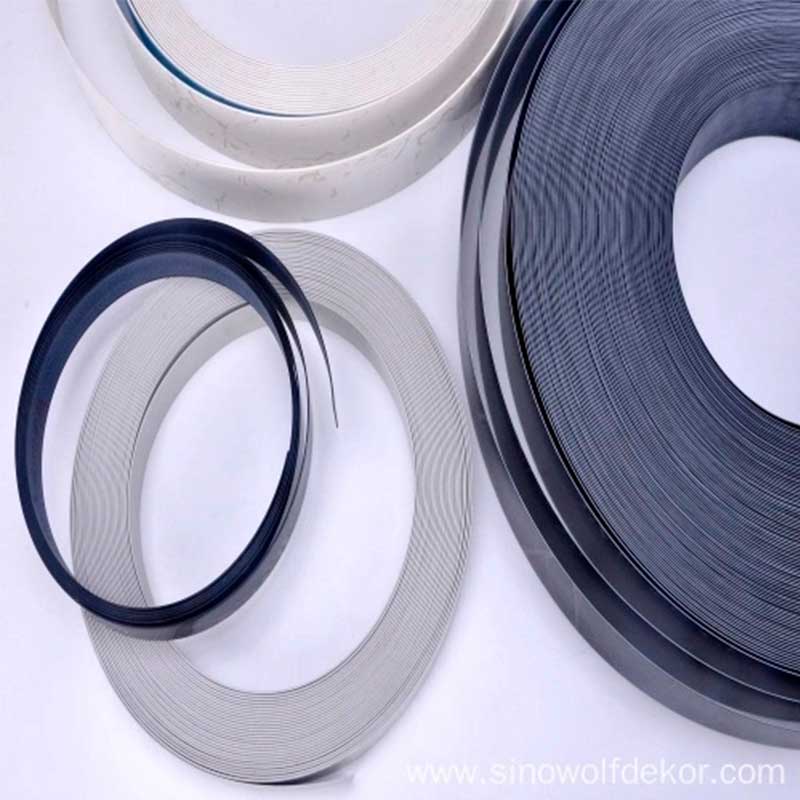In modern furniture manufacturing, PVC (Polyvinyl Chloride) edge banding has become a crucial solution for enhancing the durability of furniture edges. PVC Edge Banding not only improves the durability of furniture but also enhances its aesthetic appeal, providing significant benefits to both manufacturers and consumers. This article delves into how PVC edge banding can be used to boost the durability of furniture edges.

1. Basic Characteristics of PVC Edge Banding
PVC edge banding is a thin strip of material made primarily from PVC, widely used for edge finishing in furniture. PVC materials have excellent physical and chemical properties, such as high durability, impact resistance, chemical corrosion resistance, and aging resistance, making them an ideal choice for edge treatment.
2. Mechanisms for Enhancing Furniture Edge Durability
PVC edge banding improves edge durability through several mechanisms:
Surface Hardness: PVC edge banding has a high surface hardness that effectively resists scratches and impacts. This hardness helps prevent wear and tear on furniture edges during use, extending the lifespan of the furniture.
Wear Resistance: PVC edge banding’s wear resistance is achieved through special treatments and formulations, enabling it to withstand everyday wear and tear. Whether for residential or commercial use, PVC edge banding maintains the integrity of the edges.
Chemical Corrosion Resistance: PVC edge banding offers excellent resistance to chemical corrosion, guarding against damage from cleaning agents and other chemicals, thus preserving the edge’s condition.
Aging Resistance: The aging resistance of PVC material ensures that the edge banding does not discolor, become brittle, or degrade over time, maintaining both the appearance and functionality of the furniture edge.
3. Application Methods for PVC Edge Banding
To maximize the durability of furniture edges, correct application methods are crucial:
Edge Preparation: Ensure the furniture edge is smooth and clean before applying PVC edge banding. Proper adhesion is achieved by using suitable adhesives.
Selecting the Right Thickness: Choose the appropriate thickness of PVC edge banding based on the furniture’s environment and durability requirements. Thicker edge banding offers higher durability but may increase costs.
Heat Sealing Technology: Use heat sealing technology to bond PVC edge banding to the furniture edge. This method ensures a strong attachment, enhancing durability.
Banding Maintenance: Regularly inspect the PVC edge banding and replace any damaged sections to maintain long-term durability.
4. Choosing PVC Edge Banding in the Market
There are various types and specifications of PVC edge banding available in the market. Consider the following factors when choosing the right edge banding:
Color and Texture: PVC edge banding comes in a wide range of colors and textures. Choose banding that matches the furniture design to enhance its aesthetic and possibly hide wear marks.
Quality Assurance: Opt for PVC edge banding products that have quality certifications to ensure their durability and performance. Check product specifications and user reviews for high-quality options.
Environmental Considerations: Pay attention to the environmental aspects of PVC edge banding. Selecting products that meet environmental standards can help reduce environmental impact.
5. Case Studies
Many furniture manufacturers have successfully used PVC edge banding to enhance the durability of their furniture edges. For example, one furniture production company reported that using high-quality PVC edge banding significantly improved their products’ performance in both home and commercial environments. They found that PVC edge banding effectively prevented edge wear and damage, extended furniture life, and reduced maintenance costs.
6. Conclusion
PVC edge banding is a cost-effective and practical solution for significantly enhancing the durability of furniture edges. By selecting the right PVC edge banding, applying it correctly, and performing regular maintenance, manufacturers can greatly improve the durability and aesthetics of their products. As technology advances and market demands evolve, the use of PVC edge banding will continue to expand, bringing more innovation and growth opportunities to the furniture industry.






